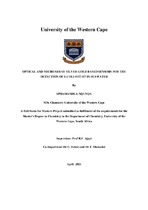| dc.contributor.advisor | Ajayi, R.F. | |
| dc.contributor.author | Nqunq, Sphamandla | |
| dc.date.accessioned | 2021-05-10T09:25:51Z | |
| dc.date.available | 2022-01-01T22:10:06Z | |
| dc.date.issued | 2021 | |
| dc.identifier.uri | http://hdl.handle.net/11394/8256 | |
| dc.description | >Magister Scientiae - MSc | en_US |
| dc.description.abstract | Recently researchers reported that nanoparticles functionalised through chemical methods possess risks to the environment and to the human health since they use hazardous chemicals and produce toxic waste. The increasing demand of nanomaterials for application in the field of science require an alternative method for synthesis of nanomaterials that are environmentally friendly, eco-friendly and non-toxic. The present study describes the green synthesis method for functionalisation of nanomaterials. Green synthesis methods are considered as a novel approach for functionalisation of nanoparticles using biological sources. | en_US |
| dc.language.iso | en | en_US |
| dc.publisher | University of the Western Cape | en_US |
| dc.subject | Green synthesis | en_US |
| dc.subject | Nanoparticles | en_US |
| dc.subject | Gold nanoparticles | en_US |
| dc.subject | Silver nanoparticles | en_US |
| dc.subject | Water pollution | en_US |
| dc.title | Optical and microarray silver-gold based sensors for the detection of e.coli 0157:h7 in seawater | en_US |
| dc.rights.holder | University of the Western Cape | en_US |

